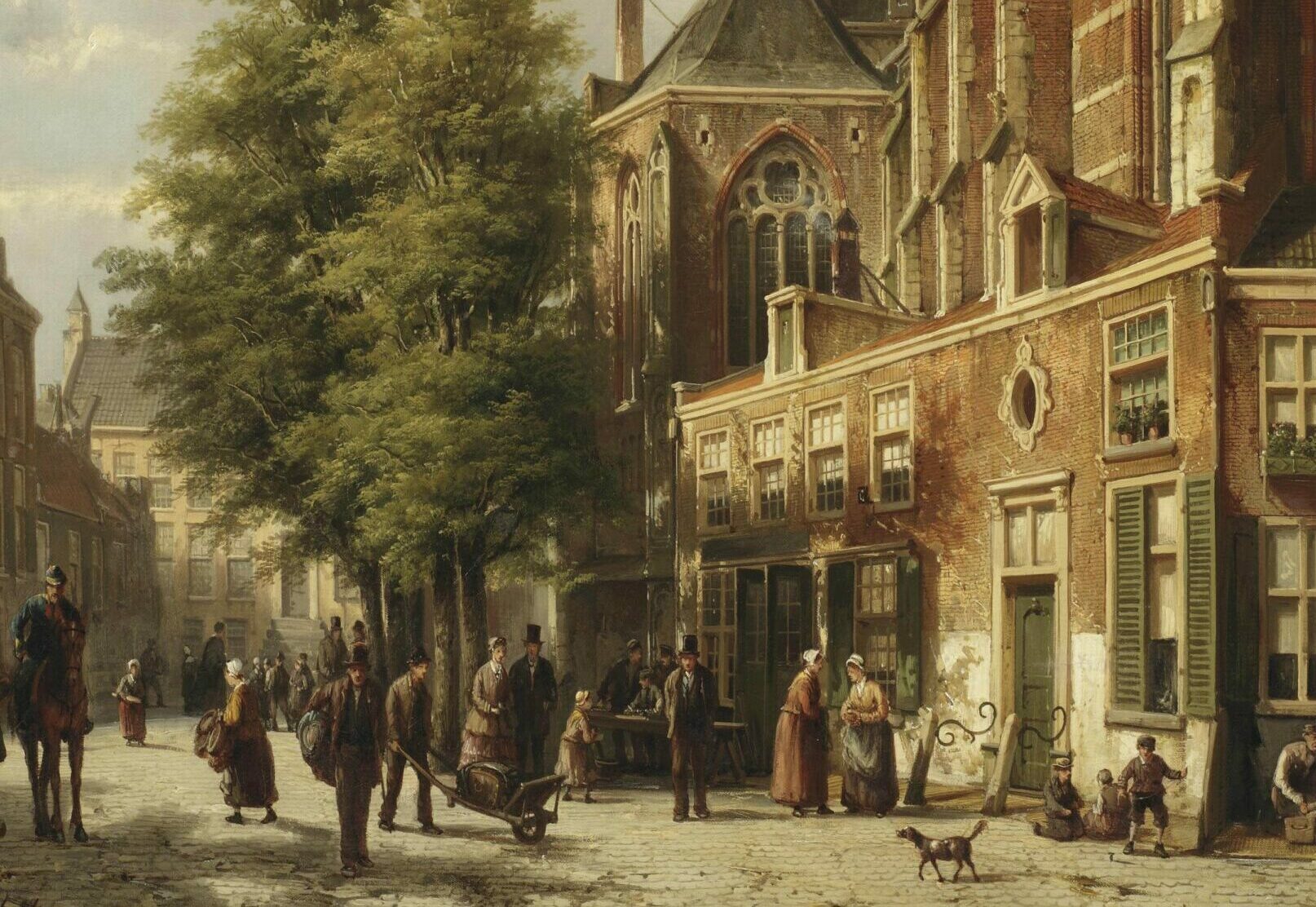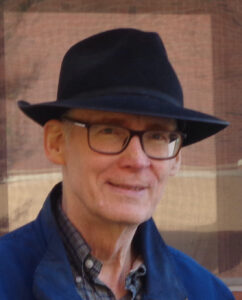Ames, IA. In the opening scene of The Tree of Man (1955), by the Australian novelist Patrick White, a horse-drawn cart comes to rest between two trees. A man gets down from the cart and unloads some possessions.
Then the man took an axe and struck at the side of a hairy tree, more to hear the sound than for any other reason. And the sound was cold and loud. The man struck at the tree, and struck, till several white chips had fallen. He looked at the scar in the side of the tree. The silence was immense. It was the first time anything like this had happened in that part of the bush.
After the primal simplicity of this beginning, with its biblical cadences and universal “man,” it’s surprising to find, as the story unfolds, that Stan Parker’s family has long owned this unvisited parcel of land, and that it isn’t far from Sydney. Stan and his future wife Amy spend the rest of their lives here, establishing a dairy farm and raising two children. They work together, fail each other several times, and take part in their neighbors’ lives. By the end of the novel their place, hemmed in by new houses and busy roads, has become an embarrassing obstacle to suburban growth.
In the beginning, though, Stan Parker’s stopping point in the forest is remote and unspoiled, accounting for White’s lofty prose. Regarded purely as a geographical setting, the site inspires an impersonal, detached awe. Viewed as the beginning of Stan and Amy’s joint venture, however, the scene takes on a different significance, albeit one no less mythical and heroic. It records an arrival at an important place, an arrival to be cherished with gratitude and wonder. With similar feelings, Jayber Crow recalls his arrival at Port William, Kentucky, there to open his barber shop, form friendships, and embark on a unique “marriage.” The people of Israel reflect again and again on the saving events that bring them to Canaan.
In fact, anyone who has lived in one place for several decades knows the lasting imprint of those tentative first days. You remember the woman who showed you around town, the diner where you had a rushed meal, the playground where the kids blew off steam. You invest the smallest incidents and the most trivial impressions with an enduring meaning—even though some of these people and events turn out, over the years, to play no consequential role in your life. They were the first things you encountered. They’re how you began.
It seems quaint now, to say the least, but some of us learned in school to see the Pilgrims’ voyage on the Mayflower as the beginning for all Americans. Mooring at Plymouth Rock was our collective scene of arrival, and the little ship contained us all like a national Ark. We all “came over on the Mayflower,” whether our forebears’ actual conveyance was a steamer, a jet, a flimsy raft, or some more sinister, shameful vessel. Something like the Mayflower myth or Stan Parker’s epic arrival undergirds many a novel devoted to a particular place. Whatever stories, vernacularisms, and one-of-a-kind locals lend a place its character, behind everything looms the essential origin.
In Localism in the Mass Age, FPR’s 2018 “manifesto,” contributor Bill Kauffman urges novelists and poets to write about the places where they live. “Every Main Street and Oak Street and Elm Street deserves its own record, its own poem,” he contends. “So where are they?” As a matter of fact they’re around, although you might not have heard of them. Here, in the following paragraphs, are three novels about three places in the world. Each conveys not just a perfunctory setting but a web of topography, livelihoods, pastimes, and lore. And in each the experience of arriving at that place endures in memory and self-understanding.
Twenty-six-year-old Frances Ellerby, the narrator-protagonist of Susanna Daniel’s Stiltsville (2010), visits Miami in 1969 to attend a college friend’s wedding. At the reception she meets a woman who introduces her to Dennis DuVal, a law student her age, and Frances ends up moving to Miami, where she and Dennis live out their marriage.
As in The Tree of Man, not much else happens. One false start or dead end after another calls attention to this uneventfulness. A plane drops mysterious packages into Biscayne Bay, raising suspicions of a drug deal—but the packages contain nothing but bait fish. At forty-seven, Frances considers having an affair with her tennis instructor—but doesn’t. Frances and Dennis learn of a murder in their daughter’s college dorm—Margo calls to say she’s fine. The central characters in Stiltsville enjoy exceedingly ordinary lives, and a blissful, ordinary marriage. The wonder of this relatively brief novel is that Daniel shapes her commonplace material into a powerful whole, effortlessly telescoping decades into thoughtful paragraphs, creating recognizable characters with a few deft strokes.
Of course a novelist can also portray a place by filling it with nonstop action. City of Light, for example, Lauren Belfer’s 1999 novel about Buffalo, New York, comes with maps and a busy plot involving Niagara Falls and the early days of electrification. Industrialists square off with environmentalists, a murder mystery unfolds, and Grover Cleveland makes an appearance as a serial seducer. Place is central to both novels, but where the Buffalo of Belfer’s crowded story feels like a well-researched, official-looking backdrop, the spare Stiltsville—quiet in language, incident, and atmosphere—delivers sticky, exotic Miami from the opening page. As much as Frances loves her husband, she’s nearly as smitten with her adopted city. “I loved the giant banyans and the dense wet mangroves and the gumbo-limbo trees and the many-sized, many-shaped palms,” she exults, in a rare panegyric. “I loved the pelicans and manatees and stone crabs and storms and even the thick, damp summers.” By the end of the novel, Dennis and Frances’s rather boring upper-middle-class lives have brought forth a convincing world of boats and water, tropical flowers and alligators, swimsuits and endless sunshine. It’s a leisurely, affectionate portrait of a city (one comfortable layer of a city, anyway), and of a marriage that begins with an awkward kiss in a fragile house on stilts.
Angela Flournoy’s The Turner House (2015) tells a more complicated story but with similar results. Instead of visiting his future home for a social event, as does Frances Ellerby, Francis Turner heads to Detroit in 1944 needing a job. He knows that the letter of commendation he bears from his pastor is not a very good one, so he looks for work on his own merits, landing at Chrysler after years of draining, degrading labor. During his “heathen period” Up North, Francis and his wife Viola, who waits in Arkansas with their infant son, are both unfaithful.
Francis and Viola are participants in the Great Migration—another collective scene of arrival—but Flournoy replaces statistics and streaming masses with the chaotic life of one Black family. Once they’re settled in Detroit, the Turners raise thirteen children, and Flournoy focuses on the ones who remain in the city. The ’67 riots, white flight, crumbling neighborhoods, and housing struggles inevitably impinge on the story, but Detroit emerges primarily through the everyday problems of Lelah the gambling addict, Troy the neighborhood cop, and several other Turner siblings. The ones who stay in Detroit become deeply attached to the city.
By contrast, Troy’s friend David Gardenhire never finds his place, as Flournoy pointedly observes: “He was not like Troy, who held on to a notion of still fitting in the neighborhood. David knew that if it weren’t for his mother and his few tenants, he’d have no reason to visit the east side. But he was not from anywhere else, either.” Attempting to weed his mother’s annuals, David pulls up some basil, to an elderly neighbor’s amusement. As readers of FPR and Wendell Berry know, nothing confirms your lack of a place like not knowing your way around a garden.
If Flournoy’s restless narrative lingers over one Turner more than the others, it’s Charles or “Cha-Cha,” carried Up North by Francis and Viola as a toddler. In his sixties Cha-Cha begins seeing a ghost or “haint” that turns out to be that of his father—despite his father’s long-ago verdict that’s become a staple of family legend: “Ain’t no haints in Detroit.” Francis’s pronouncement was apparently premature, a bit of wishful thinking based on the fact that his own father’s ghost ceased troubling him once he arrived Up North. Cha-Cha, born in the South like Francis, must suffer the enduring grip of his origins.
“What’s the difference between a haint and a regular ghost anyway?” Lelah asks Troy. “Is a haint just a southern ghost? A black-folks ghost?” As Cha-Cha discovers, the answers are yes and yes. Although he’s the only one who sees spooky blue lights and a talking specter, all the Turners must deal with their southern, black-folks ghosts. Simply arriving in a new place gives no assurance that the evils and hardships of the old place are left behind.
What if one’s arrival is purely random—spurred by no particular need, aimed toward no destination? Can such an arrival have any lasting significance? July Montgomery, the ubiquitous central character in David Rhodes’s Driftless (2009), wakes up on a roadside in Wyoming, discovers he’s been robbed, and catches a ride with a cattleman returning to southwestern Wisconsin. When the old man hits a pothole and stops to check for damage, July gets out, says thank you and goodbye, and starts walking. He comes to a tiny town called Words, where he spends the rest of his life on a small farm.
Lest we suspect Rhodes of some kind of postmodern trickery, he explains that the town gets its odd designation from a surveyor named Elias Words. We’re also told that “the current denizens of Words remained stubbornly rooted in an outdated idea. Like people who refuse to update their wardrobes, they simply ignored all evidence that their manner of living had expired.” They “depended on agriculture for their livelihood, on work for exercise, on common sense for intelligence, on each other for entertainment, and on faith for health.” Pitted against the soulless systems of “the modern world,” the underdogs in Driftless fight their uphill battles. A young musician has her dream come true, performing an original song for her favorite singer—only to see her idol hijack the song and smooth it into a slick studio product. Winifred Smith, pastor of the Words Friends of Jesus Church, attempts with predictable results to talk a casino manager into returning forty thousand dollars to a confused, overzealous church member. Like an angel in work clothes, July Montgomery keeps materializing beside these downtrodden idealists, offering advice, comfort, a sympathetic ear.
The biggest, most lopsided fight in Driftless plays out between the local dairy farmers and the higher-ups who control prices and carry out inspections. Smelling a rat, producers Grahm and Cora Shotwell start looking into the numbers. Immediately their records disappear, their inquiries are stonewalled, and their milk is mysteriously contaminated with antibiotics. But word of the Shotwells’ campaign gets out, and more farmers join the uprising. For Grahm and Cora, hope kindles when July quietly recruits a lawyer couple he knows. His shrewd friends can muster up nothing more, however, than tactical victories and the distant hope of a partial settlement. At a meeting of increasingly desperate farmers, the local militia leader urges a more radical approach: direct action against the corporate and government roots of corruption.
This is when July Montgomery makes his big speech. He agrees with the militia leader and the other activists about the evils of greed and power. He attended the meeting, he says, because he wants to contribute in any way he can to the struggle. But what he really cares about are “more important, private things.” He’ll sign the moderate faction’s petition, but to the militia leader he says, “[Y]ou want me to do something else with my life and I simply don’t have time for that. As I said before, I like farming. I like going to county fairs, listening to music, and eating my neighbor’s pies. None of that involves fighting with anyone.” July doesn’t reject collective action or political remedies; he merely prefers, as his comings and goings around town attest, to deal with persons rather than institutions.
Late in the novel, July lets himself remember why he’d been drifting around the country when he woke up in Wyoming. His young wife was murdered during a burglary, and he’s “never gotten over her.” Beginning life again in Words, he “rediscovered their love in his neighbors.” That love explains why he’s always there when his neighbors need him, why he listens to their mystical visions and their love-struck ravings, why he chides them when he thinks they’re making mistakes and then steps aside.
There was no reason why July walked into Words, Wisconsin, and not some other Midwestern town. The old man he rode with could have dropped him off anywhere. Sometimes, for anything any of us can tell, arrivals just happen, then stay with us for the rest of our lives. In July’s case, he embraces his town by an act of will. Others might choose an act of faith. Whatever we do—and however we got there—our attachment and affection can deepen and grow from such unlikely beginnings until one day we discover we’re home.




